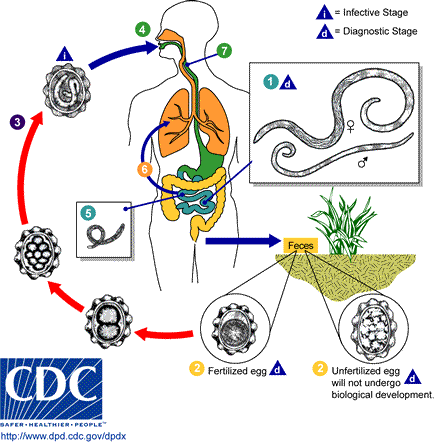Biology
Causal Agent:
Ascaris lumbricoides is the largest nematode (roundworm) parasitizing the human intestine. (Adult females: 20 to 35 cm; adult male: 15 to 30 cm.)
Life Cycle:

Adult worms ![]() live in the lumen of the small intestine. A female may produce approximately 200,000 eggs per day, which are passed with the feces
live in the lumen of the small intestine. A female may produce approximately 200,000 eggs per day, which are passed with the feces ![]() . Unfertilized eggs may be ingested but are not infective. Fertile eggs embryonate and become infective after 18 days to several weeks
. Unfertilized eggs may be ingested but are not infective. Fertile eggs embryonate and become infective after 18 days to several weeks ![]() , depending on the environmental conditions (optimum: moist, warm, shaded soil). After infective eggs are swallowed
, depending on the environmental conditions (optimum: moist, warm, shaded soil). After infective eggs are swallowed ![]() , the larvae hatch
, the larvae hatch ![]() , invade the intestinal mucosa, and are carried via the portal, then systemic circulation to the lungs
, invade the intestinal mucosa, and are carried via the portal, then systemic circulation to the lungs ![]() . The larvae mature further in the lungs (10 to 14 days), penetrate the alveolar walls, ascend the bronchial tree to the throat, and are swallowed
. The larvae mature further in the lungs (10 to 14 days), penetrate the alveolar walls, ascend the bronchial tree to the throat, and are swallowed ![]() . Upon reaching the small intestine, they develop into adult worms
. Upon reaching the small intestine, they develop into adult worms ![]() . Between 2 and 3 months are required from ingestion of the infective eggs to oviposition by the adult female. Adult worms can live 1 to 2 years.
. Between 2 and 3 months are required from ingestion of the infective eggs to oviposition by the adult female. Adult worms can live 1 to 2 years.
Life cycle image and information courtesy of DPDx.
- Page last reviewed: March 18, 2015
- Page last updated: March 18, 2015
- Content source:


 ShareCompartir
ShareCompartir